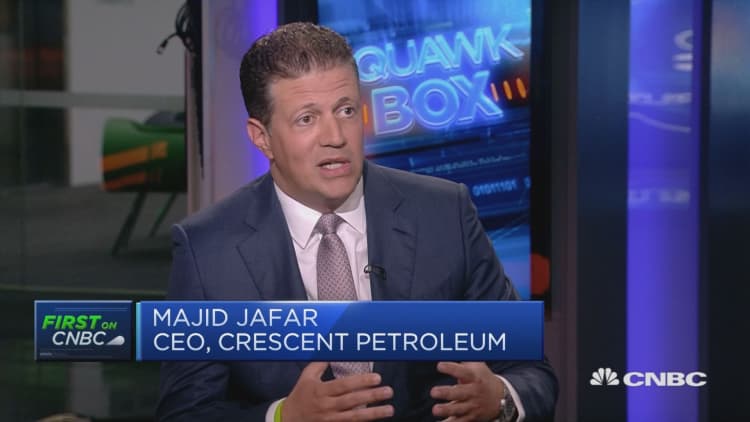OPEC's second-largest oil producer hit record production figures in August with an output of 4.88 million barrels per day (bpd), according to the latest figures from S&P Global Platts.
Iraq's highest-ever production count has contributed to what may be OPEC's first monthly output rise of the year, throwing a wrench into the 14-member organization's plans to limit global oil supply and keep a floor under declining crude prices.
"The recent increases in Iraqi production turned what was a sort of minor headache for OPEC into a fully-blown migraine," Dave Ernsberger, global head of commodities pricing at S&P Global Platts, told CNBC on Thursday.
The problem for the cartel, Ersnberger says, is twofold. "It makes it more difficult for OPEC to manage the perception that it will balance markets, as demand is currently under pressure."
It also creates "tremendous pressure" within OPEC itself, as these production gains come at the expense of Iran, he added: "Whenever Iranian production is under pressure and Iraqi production increases, keeping the peace within OPEC becomes incredibly difficult to do."
To put Iraq's 4.88 million bpd figure in perspective, the country's output five years ago was 2.96 million bpd, and between the 2003 U.S. invasion of Iraq and 2010 it veered between less than half a million barrels per day to barely touching 2.5 million. After more than 15 years of conflict and a dire need to rebuild, Iraq's government hails this growth as a success.
Iraq's crude oil exports also increased to 3.6 million bpd in August, from 3.56 million bpd the previous month, according to its oil ministry.

Meanwhile, a recent Reuters survey found that OPEC saw its first production increase of 2019 in August to 29.61 million bpd, up 80,000 bpd from the month prior. The group in early July announced its decision to curb output into 2020 to boost prices amid a dim demand outlook and rising shale production in the U.S. But the price of oil still remains depressed.
Iraq's production, then, "is a pretty significant problem for OPEC," Ernsberger said. "And it will further make it difficult when OPEC comes together to find acceptable ways forward heading into the end of the year."
"Saudi Arabia, OPEC's de facto leader… has repeatedly called on Iraq and other less compliant countries to get with the program, but this has mostly fallen on deaf ears."Herman WangSenior oil writer, S&P Global Platts
The Arab country of 38 million, home to 12% of the world's proven oil reserves, has seen improved output primarily from its southern oilfields, as gains in its north are still hampered by political disputes between Baghdad and the Kurdish regional government. Its super giant Majnoon field in Basra saw production double to 200,000 bpd in June after having been curtailed at the beginning of the year due to its OPEC quota.
"Adherence to the quota no longer seems to be a priority," said Herman Wang, a senior oil writer at Platts. "The country has recovered well since the Islamic State was largely driven out, and production has been on a steady rise, particularly in fields operated by foreign oil majors."
Iraq's revenue needs vs. OPEC demands
Iraq actively sought an exemption from OPEC's cutting program in November 2016 because of its revenue needs amid severe economic and security challenges. But it ended up bearing the second-largest cutting requirement in the group, struggling to comply ever since. Iraq was later added to the Joint Ministerial Monitoring Committee (JMMC), OPEC's nine-member monitoring committee, but that doesn't seem to have helped ensure compliance.
"There really is no enforcement mechanism to ensure compliance with production quotas," Wang said. "Saudi Arabia, OPEC's de-facto leader … has repeatedly called on Iraq and other less compliant countries to get with the program and stop free-riding, but this has mostly fallen on deaf ears."
Stephen Brennock, a commodities analyst at PVM Oil Associates in London, said Iraq's high figures of late "suggest that it may be nearing the limits of its production capacity."
However, he told CNBC he expects further modest gains thanks in part to Iraq's working with foreign partners to boost infrastructure.
"Needless to say," Brennock added, "this will give OPEC kingpin Saudi Arabia cause for concern given that the group is under pressure to deepen cuts if it is to prevent a glut returning next year."
The country remains saddled with damaged and outdated infrastructure and reconstruction that could cost as much as $100 billion, so its oil production will face continued obstacles.
A lack of pipeline and export capacity in the southern Basra governorate, which holds 70% of Iraq's proven crude reserves, is one potential barrier to near-term growth, says Helima Croft, global head of commodity strategy at RBC Capital Markets.
But after nearly two decades of war, displacement and foreign intervention, many feel Iraq is within its rights to welcome such robust growth in its oil sector, which provides 90% of its government revenue.
"For all of the OPEC compliance issues, Iraq's production growth is a pretty remarkable achievement considering all of the obstacles they were facing," Croft said.


